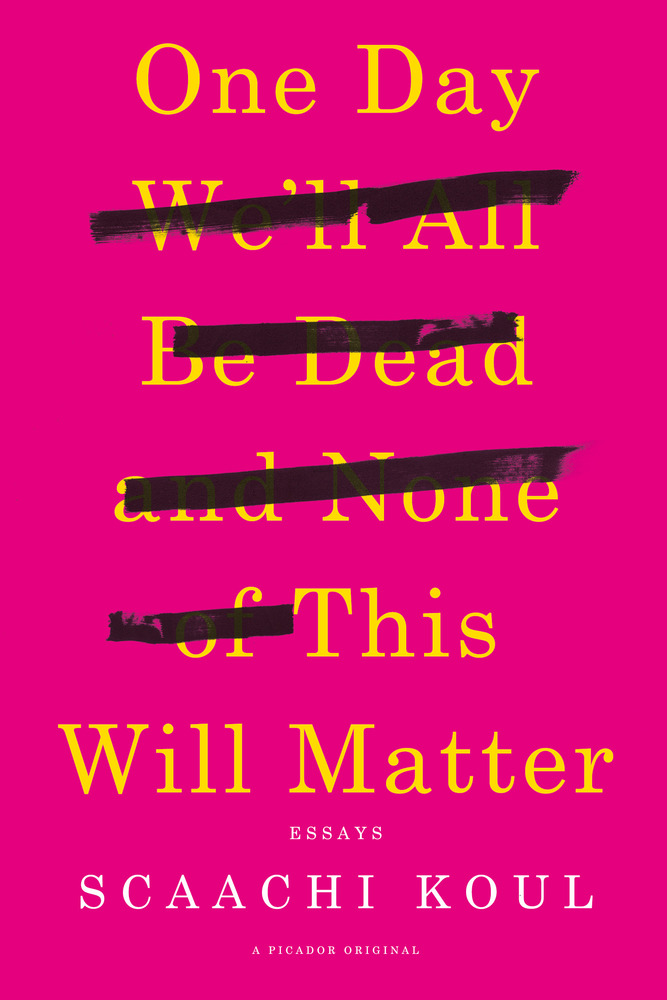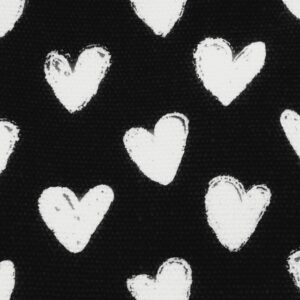
New Clothes Won't Fix You (and Will Likely Cause Shame and Discomfort)
The Time Scaachi Koul Got Trapped in a Skirt
Among the many unfair stereotypes lodged against women—small hands, delicate fingers, weak arms, poisonous knees—is the belief that we all love shopping. There is nothing all women like, except maybe television shows where other women scream at each other or have long discussions promoting the demise of the modern man so that we can all live in some utopian future where we can procreate on our own and can finally stop pretending that any of us appreciate having the thin, eerily soft skin of a testicle in our mouths. But shopping is a strange thing to attribute to a specific gender. What about it could be so intrinsically satisfying?
I don’t like shopping. In movies that depict a futuristic dystopia, people tend to wear uniforms in a single color, usually a metallic onesie with a high neck and gender-neutral panelling in the front. I am fine with this. I look great in silver and gold. Shopping reveals the id in all of us. At blowout sales, I am ready to cold-cock other women also trying on size 10 work-appropriate cocktail dresses that hide their shame (upper arms) while promoting their glory (elegant pinkies and/or pillow-butt). In the changing room, attempting to shove your misshapen body into the size you think you should be rather than the size you are usually leads to some form of weeping while screaming, “IT’S FINE, I’LL JUST WEAR A BAG OF FLOUR AROUND MY BODY UNTIL I DEHYDRATE ENTIRELY AND CAN DIE IN PEACE.”
Opening your closet to find that you hate every item of clothing you have ever bought is a specific circle of hell: hanger after hanger of poly-cotton blend T-shirts, all with thick layers of deodorant crusted on the armpits, every skirt ironed so poorly it’s on the verge of unravelling if you swivel too fast in it, your shoes just leather hunks you force your bunions into.
But despite this hatred of shopping, I have faith in clothing, in its ability to transform you into something or someone better. At our cores, we are all swirling masses of infectious disease, pulsating orbs of pus, moist tubes filled with piss and shit. But maybe if we put on a nice suit or one of those giant statement necklaces that suggest we have more money than we do, someone else will think us clean enough to touch, to go to dinner with, to greet without flinching, to introduce to their parents.
That is why we go shopping. To touch even the tip of our humanity.
Around the age of ten, I gained a significant amount of weight, the kind that family members stop referring to as “cute” or “baby weight” and start referencing with a heavy sigh. There was, in reality, nothing wrong with my weight, but I was too young and too insecure (a lethal combination) to know that. So I did what I thought I should: I hid my rapidly developing body. I started wearing B.U.M. Equipment sweatpants and long-sleeved heat-locking tops—both items were perhaps utilitarian in the winter, but tended to turn my person into a walking, sweating radiator by June. Shopping was my mother’s game. She would return from stores that sold clothes exclusively for hikers with a wagonful of wool socks and dungarees for her puberty-stricken daughter. Nothing I owned fit anymore, and I didn’t trust that buying the right clothes could make me feel better about the way my hips had widened or my arms had softened or my neck now had ridges running across it as if I were an old tree and these were my rings.
At the time, I claimed my style was some kind of feminist protest: “I don’t need to look like every other girl. Why should I have to dress up when guys can wear whatever they want?” I listened to Avril Lavigne and recited the lyrics as if they were my own thoughts; I watched CNN because I didn’t want to be a frivolous teen; I had crushes on adult men like Jon Stewart and Rahm Emanuel and hot dads at the mall with salt-and-pepper hair and Palm Pilots.
But in truth, I just didn’t know if I was allowed to look like a “cute girl” if my body was bigger than the other girls I knew, if my skin was darker, if I was more sullen than sugar. I hid in muted drapery hoping no one would notice or, better yet, they would assume I was just a very tough, genderless sphere. This crumbled by the time I was eleven: a well-meaning woman at my mother’s Jenny Craig meeting told her what a precious son she had. I was wearing a baseball cap with the Coca-Cola logo emblazoned on the front, a red puffy vest, and grey sweatpants. It was July. It was embarrassing to be mistaken for a boy. Not a girl with masculine tendencies, not a girl rejecting traditional gender roles, but a boy. I was being defined by my clothing instead of transformed by it. This was the same year I discovered Lord of the Rings weenie Orlando Bloom, a crush that would last 24 months and spawn more than one fan club. (My brother was the only member, and only by force.)
Boys don’t like girls in promotional hats, and I wanted boys to like me. I started growing my hair out, and asked my mom to take me shopping. I wanted to dress like a girl, and not just a pretty girl but a hot girl, that poor definition of whatever makes a woman worth looking at, worth touching. At least, from a teenage boy’s perspective. Clothes, the right clothes, could make me—even me!—hot.
Unfortunately, my tastes differed drastically from my mother’s. My interests were swaying towards T-shirts with hilarious and racy sayings paired with elastic-waistbanded jeans. I wanted to try on belly tops and white belts with big silver bolts! My mom suggested matching stretchy pants and long-sleeved tops with watercolor wolves standing near the reflection of the moon in a calm river, T-shirts with little frogs posed on 3D lily pads, flowing Indian tunics that I could tell were clearly not “English” clothes, as we called them, ones in jewel tones and gold stitching that screamed, “MY MOTHER IS AN IMMIGRANT, WE ONLY EAT OFF METAL PLATES.” She’d hold them up and say, “They look so nice!” and I’d say, “They’re itchy!” and she’d say, “How?” and I’d furiously rub the sequins against my skin until I flashed red bumps and then say, “SEE?”
A particular fight between my mother and me broke out in the women’s aisle at Walmart the summer before I started middle school, when I found a royal blue shirt with “IF IT WEREN’T FOR BOYS, I WOULDN’T EVEN GO TO SCHOOL” scrawled across the front in harsh yellow. This was a completely false statement for me to support: I wrote extra-credit English essays, joined the school paper, and wept for weeks when my grade-six yearbook failed to print my “Future Goals” next to my school photo, worried that everyone would think I was a purposeless hack. I was afraid of the boys who went to my school, all of whom did not like me and were prone to calling me a faggot. But I felt that if I got this shirt, I could transform myself at my new school. I would be cool and elusive and one of those types people refer to as “chill.” What does that even mean? I still have no idea, but I wanted it, and even now, as a tense, uncomfortable adult, I forevermore aim to be “chill.”
I had the whole scene planned out: I would walk into school wearing that shirt, along with a set of earrings from Claire’s, the ones shaped like lightning bolts to really bring out the yellow in the shirt. I’d pair it with my floorlength patchwork denim skirt with a little Union Jack on the pocket—I did not know the flag’s country of origin, but it’s not like there was a class I could take at school to teach me junk like flags or stuff. I would encircle my eyes with thick black liner, all the way around, elevating myself from mousy girl to sex-raccoon. Graham, the boy I had the hots for, would really see me for the first time. Not as the girl he once tackled in flag football, but as the woman he once tackled in flag football. I would pull my glasses off and the transformation would be complete. Who is this girl? everyone would ask. It’s me, I’d say. The crowd would gasp in amazement and I would have a million friends and be very thin and rich and filled with an embarrassment of sexual energy for a 13-year-old.
While I was concocting this elaborate fantasy in Walmart, my mom was explaining to me why she wouldn’t be buying the shirt. “That’s inappropriate,” she whispered, as if the words themselves were sinful. My mother had a tendency to slip into outrage and shock as a first reaction to anything, and the lower her voice dropped, the more she was disappointed in me. I could barely hear her. “It’s not even long enough to cover your tummy!” she said, pulling me towards a row of long-sleeved T-shirts that said “Glam!” in different colors.
We settled on a short-sleeved number with glittery navy vinyl lettering that proclaimed “I’m not perfect, but I’m so close it scares me!” Even though I loved the shirt (so clever, so quietly smart, so, dare I say, elegantly subversive), I raged at my mom for weeks. She claimed that shirts like the royal blue one were intended for women like my 20-year-old cousin and not for pudgy middle-schoolers. But what 20-year-old is shopping in the girls’ section at Walmart, Mother? It got worse a few days after classes started, when my arch-nemesis, Stephanie, wore the shirt I’d wanted, getting an obscene amount of negative male attention. I stomped all the way home that afternoon. That was supposed to be my negative male attention.
This thinking—finding an outfit that I believe will revolutionize my very existence—is a repeated one of failure throughout my life. There was the pair of faux-leather red peep-toe pumps in 2006, the high-waisted oatmeal-colored wide-legged trousers of 2008, the black-sequined bolero of 2009, the skin-tight cerise knock-off Hervé Léger “this New Year’s Eve is gonna be amaaaaaziiiiiing” bandage dress of 2011 that I still own and pull out from my closet now and then to remind myself of what I cannot be. I still remember my favorite outfit from the tenth grade: a mint-green V-neck lace top, dark-wash boot-cut jeans, and black-and-teal-butterfly Mary Jane kitten heels. I wore that outfit for every major occasion: when I wanted Drew to ask me out (he did not), when I wanted to ace a math exam (I did not), when I wanted to be noticed by an attractive guest speaker (I was not). Despite this piss-poor batting average, I felt a renewed sense of potential every time I put it on. Today, something good has to happen.
Nearly a decade after that outfit stopped being a staple in my wardrobe, I yet again fell into the trap of believing clothing could be revolutionary. Walking through Toronto’s financial district, I passed a clothing chain known for simple skirts, blouses, blazers, and a terrible roll-on perfume that burned my neck. It was also the second (and last) retail job I ever had, when I was 19 and living in my cousin Angie’s basement beside her husband’s table saw, which he used to make her hand-carved wizard wands.
I was at least 20 years younger than the clientele that came into the store, I hardly made enough money to buy the $90 cocktail-casual dresses on the racks, and I managed to be 20 minutes late for every shift. I wasn’t fired, per se, but when I left my section of the store to reapply my $4.50 lipstick and a drunk man managed to swipe $800 of merchandise from the store without being detected, I nobly offered not to return for my next shift.
But that was years ago, and I felt a twinge of self-satisfaction in going back as a customer. So much of my life had changed since I had worked there: I wasn’t a teenager anymore, I had my own apartment, I had paid my taxes at least once, I bought shoes in real stores instead of waiting for my older cousins to tire of theirs. The store was little more than a reminder of how far I had progressed in a few short years. Help me with these buttons, shopgirl , I imagined saying, for I am an important woman. I own a microwave.
That said, the real reason I entered the store was far more practical than ego. It was the dead of summer, some 35 degrees Celsius, and I am a soggy woman even in the most forgiving conditions. Standing outside the store, I was already sweating in new and interesting parts of my body, and if I didn’t get into a building colder than the surface of the moon, my makeup would start bleeding and I’d look like a wax figurine inside a clay oven.
I walked in, relishing the blast of cool air, and immediately saw Aaliyah. She had trained me when I worked there but was now the store manager and still as tall, stately, and glamorous as I remembered her being when I was 19. Best of all: she didn’t seem to recognize me.
I rummaged through sales rack after sales rack, tossing aside shirts that I knew would cling in the wrong places, colors that brought out the sallow tint of my complexion, and the one-piece jumpers because, inexplicably, adult women were wearing jumpers in droves, and I never figured out how all of them managed to pee while wearing them. I was older, more mature, I had learned some important lessons.
But like most of my shopping trips, I grew frustrated quickly. There was little in my size, and the few things that were listed as an 8 or a 10 were really cut for someone who was a 4 or a 6. Just the thought of forcing my wide hips through trousers or my boulder shoulders through a T-shirt felt like more pain than it was worth.
And yet, on my way out, I found it: the thing. A black-and-white fall skirt that I knew would look perfect on me. It was soft wool, but in a slimming cut, and hit just below the knee. It would be perfect for work, or for going out after work, or maybe I would wear it with a big floppy hat and a trench coat at Parisian cafés, waiting for a parcel from a mysterious stranger. (I am Carmen Sandiego in this fantasy, like I am in most of my nonsexual, non-food-related fantasies.) I held my breath, turning it over to see the price and the size: it was on sale, and it was a size 8.
It’s happening , I thought. The item, the big item that changes the way I dress and thereby changes the way I am as a person. It’s not just a skirt; it’s the entry fee for a better existence. I would exude a new confidence, it would smooth out the wrinkles in my body, it would hide all the ways I have disappointed and failed people in the past. While wearing it, women would approach me and beg me to tell them where I got it. I would act coy and wink to the camera (in this version of the fantasy, I am perpetually in a commercial; don’t worry about it) and say something like, “I’ll never tell” or “Oh, just something I picked up.” People would see me on the street, shoving fistfuls of Teddy Grahams into my mouth on the way to the podiatrist, and they would think, “Boy, that lady sure does have her life together.”
That’s a lot of pressure for something on sale for $24.99.
Aaliyah led me to a changing room, complimenting me on my choice. I locked the door and looked at myself in the mirror, taking a deep breath. This could be it. I peeled the shorts off my sweating skin and stepped into the skirt. It slid up my body, resting on my waist, and I pulled the zipper up towards the lord. It didn’t just fit. No, it did more than that. It melded to my body, beautifully, as if it had been cut specifically for me, to mask and smooth and elevate. I would be better in this skirt. The dream was happening! I had the all-knowing smile, my hair was suddenly more luxurious, I felt thinner, more acceptable. I was a better woman. Girls who had been mean to me in high school would see me in this skirt and think, “Is that Scaachi?” and I’d say, “YOU BET IT IS, YOU DUMB BITCH” and then punch all their boyfriends in the teeth. (I have not thought this fantasy through; just let me have this.)
Conflated imaginings aside, I did look pretty good.
I walked out of the changing room to vamp in front of people paid to tell me I looked great. The skirt was a little warm for the summer, but who cares, I’d wear it when fall came. I did one more spin in front of Aaliyah and her co-workers before feeling a thick droplet of sweat fall from my brow onto my eyelash. I was overheating in my perfect skirt, so I headed back into the changing room.
My hands were sweating too much to grasp the zipper in the back. I wrapped a T-shirt around my fingers to get a grip, but it wouldn’t budge. I sucked in, gathering the fabric, and tried to tug the zipper down. No luck. I struggled like this for a good 15 minutes, the changing room lights feeling more like an interrogation lamp, sweat pooling in the dimples above my ass, my hair matted to my face.
I had fallen into this trap before, so many times. Years before this, I went through a phase of buying clothes only from vintage stores: beautiful dresses and skirts that required real care and attention that I wasn’t willing to give to another person, never mind a chiffon gown. They had no elastic, bled color wherever you sat, with zippers that rusted and fell apart like rotting teeth. My favorite purchase was a cocktail dress: it was a simple blood-red shift that came with a layer that slipped on top, a long peplum type that made my waist look small. I wore it too often, too many places. Paired with irrational brown heels, I wore it to school with my hair done and red lipstick, as if at any moment, someone would rush into my JRN 121 class and say, “Help, I am a very wealthy lawyer and I need an extremely well-dressed young woman to join me on my yacht for a party that might have some influence in making me partner. Also, I am looking for a wife to politely ignore but who may spend my money freely and maintain multiple quiet affairs with my handsome co-workers. You look ironed. Are you interested?”
But I didn’t know how to care for the dress. It had been made in the 1950s for a woman an inch or two thinner than me, so I was already testing the tensile strength of the seams. I hand-washed it in cold water—isn’t that what you do with delicate items?—the dress bleeding out its red color, fading it slightly. But it also shrank, somehow, now only reaching halfway down my thigh. It was too much for school (oh, now it’s too much) but fine for any other occasion. Yes, it was so tight on my ass and hips that I couldn’t sit down in it, but that just meant I’d wear it to run errands. When my cell phone broke and I needed to get it repaired, I wore my favorite dress and my brown heels to the mall. While the rep explained the damage to my phone (“Unfortunately, we can’t replace any phones that might have been dropped in liquids or foods, and I can see some marinara in the headphone jack”), I felt the dress tear right between my butt cheeks. There was no seam there, but certainly some considerable tension.
I pressed the flap of the top layer of the dress down over the new hole and tried to scurry out. Before I left, the rep stopped me to say, “By the way, I really like your outfit.” I kept the dress just in case my body one day became drastically different and I could maybe fit in it again. After, of course, repairing the six-inch-long tear in the back.
But back in the changing room, I was reaching peak anxiety. I tried pulling the skirt over my head (alas, my waist is smaller than my shoulders, a problem I did not consider until I almost got my arms stuck in the skirt as well), then considered tearing the zipper and telling Aaliyah that it broke while I was trying to disrobe.
But I didn’t want to ruin such a good item. Maybe it was salvageable. Maybe I could still be the woman I felt I could be. My only options were to ask Aaliyah to help me out of the skirt, or to wear it out of the store, making me the only idiot sweating in a wool skirt in thirty-degree heat who wasn’t also handing out pamphlets that read “Have You Made Peace With Your God?” Sometimes zippers move when you rub a candle on them. I could run outside and yell, “DOES ANYONE HAVE A CANDLE? IT’S AN EMERGENCY.” That would be fine. I considered a secret third option in that changing room, one where I would type out a quick suicide note on my phone and then use a fabric belt to fashion a trendy noose.
Whatever the decision, I needed to make it fast, since soon my whole body would be covered in my salty, sticky shame-sweat. I left the changing room and tapped Aaliyah on the shoulder, hoping she wouldn’t notice my entire face was glistening. “That really does look great on you,” she said, giving me that wide smile I had seen her give to so many customers before.
“I’m stuck,” I said.
I turned around, my rear towards her, and she tried the zipper herself. She tried bunching the fabric to get a better grip. “Suck in,” she said, pulling more and more of the skirt towards her. She called over her co-worker to help. She, too, couldn’t manage. “It’s so weird,” she said. “It’s like the skirt is caught on nothing.” No, nothing except my own ego and humiliation. I flew too close to the sun with this skirt. I thought it would transform my life. I thought it would make me better.
A third employee came over and tried to use a pin to pull the zipper’s teeth apart. She spent a full minute just shaking my hips, as if she was trying to will me to a smaller size so the skirt would slide off. (Admittedly, a minute may not sound like a long time, but ask a loved one to shake the lower half of your body vigorously for an entire minute, and then ponder how long those 60 seconds feel like.)
The employees turned to each other and discussed what to do next. “We could rip out the zipper and then sew it back on?” “Do you think she can pull it over her head, or, no, no, her shoulders are too wide.” “What if we just cut her out?”
That last one was the ultimate nightmare. If you are a woman reading this, you know this to be true: the possibility of getting stuck in a garment at a store where the employees have to cut you out of it is the beginning of the end of your life. It’s like the saddest version of a C-section, where the baby is just a half-naked lady with no dignity.
“Yeah,” Aaliyah said to her cohorts. “Grab the scissors. We have to cut her out.” It was like listening to three surgeons decide you needed to be sliced in half, thinking you’re unconscious and can’t hear them. Two women held the skirt to my hips, pressing me into the wall of the changing room hallway. I could see my reflection in the mirror, my face now drenched with sweat. From the outside, I looked like I was being hazed by a group of women far too old to be welcoming in new pledges. All I was focused on, however, was not exposing my entire lower half to whoever may have walked into the store during this ordeal. I said a silent goodbye to my beloved skirt, the garment that was supposed to change me but instead reminded me that, no, you are what you are, even if you remember to iron your clothes.
“Okay, hold still,” Aaliyah said. This was an intimate moment for us. Her face was closer to my butt than anyone’s had been in, oh, hours. We were like sisters now. While the other two women flanked me and held the skirt up, Aaliyah pulled the fabric away from my body and started making small cuts. “I don’t want to cut you,” she said, but at that point, I welcomed any distraction from the sweat gathering on my back. Like tiny, resplendent pools of my greatest fear come to life.
The sound that’s made when one cuts a perfectly useful item of clothing is almost painful, especially when it’s one that you have fallen in love with. All those hems and seams and stitches destroyed so easily. It’s the same feeling, I imagine, that would come if you baked and iced a cake, only to drop it on the way to a birthday.
But the sound that’s made when someone, say, cuts an item of clothing they weren’t supposed to cut is criminal. It’s the dying scream of someone you love. It is the final whisper of your pride. It is the quietest slap in the face you will ever feel.
When she made her final cut, I turned to Aaliyah to thank her—maybe I would make a joke about how we had worked together, how I had let all that merchandise just walk out of the store and here I was, doing it again—but all the color had drained from her face. She had sliced right through my underwear, leaving me exposed like either a confused surgery patient or a very physically confident crazy person.
It was an honest mistake on her part. I hope. I was wearing one of those 1999-esque whale tails that were popular among high school girls trying to attract boys with the forbidden fruit of tiny underwear. It wasn’t so much clothing as it was thickly woven black floss, hanging out inside the crevices of my garbage body.
Aaliyah wordlessly ushered me back into the changing room, then gave me the scissors, saying I could cut myself out further if I needed to. I tore the skirt right in half, looking at what was hanging off me in the mirror. One hip, wrapped in an elastic band like a still-raw roulade, the other naked except for a thick thread swinging, purposelessly, by my side. I started to get dressed, trying to see if I could tie my underwear back together or maybe cinch it with the hair elastic I had around my wrist. Instead, I opted to just stuff myself back into my denim shorts.
I handed Aaliyah the remains of the skirt and the scissors, apologizing for destroying a perfectly good item of clothing. “Oh, it’s okay,” she said, “it happens,” though she didn’t clarify to whom else it had ever happened. I bought that trendy noose belt to compensate. And then, of course, as I shuffled out of the store, I heard Aaliyah proclaim with great zeal, “Oh my god, I just remembered where I know her from!”
The nightmare was over, but I still had to sulk home in a heat wave, my clothes soaked from sweat, my underwear hanging on by a single thread. And if you have never experienced the sensation of your naked labia rubbing up against freshly washed denim as you maneuver through a subway car with broken air conditioning, you have had more than your fair share of luck in this life.
I returned home the way I always do, with no renewed outlook on life and no magic garment to change the way I am. I hung my new belt (still never worn) in my closet among all the other clothes that I had, at one point, bought in order to improve my life. All of them had failed me because clothes just can’t improve you. They can’t make you feel better about yourself for more than a few minutes, they can’t make you a better person than you are, because they’re all just things you bought at the mall, that you then ruin with pizza sauce stains, that you then wear to bed or use to polish jewelry. I still go through the same routine where I shop to save my soul instead of just to cover my ass, and it typically ends the same way. That maxi-dress from nine months ago didn’t cure me of hating the width of my hips. The earrings from two years ago don’t distract me from how I feel about my uneven hairline. And the skirt Aaliyah cut me out of would not have made me feel any better about how quickly sweat can puddle at the nape of my neck. I wonder, sometimes, if my mom had just bought me that shirt from Walmart, if I would have been saved all this nitpicking I do to my own body: maybe I would be kinder to my arms and my neck, maybe I wouldn’t worry about what people might be saying about my baby hair.
But probably not. There will be something else to make me feel bad, inching up towards all the things I currently feel bad about, and no crop top made by small, underpaid, foreign hands can cure me—or you. Clothes are ephemeral: they fall apart in the wash, you lose them at a friend’s house, they rip and crumble and go out of style. You’ll forget about them and buy new ones and then start the cycle again. But your insecurities, the ones that make you go hunting for something to make you feel better, to love yourself more, to give you a renewed sense of self or greater esprit—don’t you even worry. Those will last you a lifetime.
__________________________________
Originally titled “Size Me Up” this essay appears in One Day We’ll All Be Dead and None of This Will Matter, courtesy Picador. Copyright 2017 by Scaachi Koul.
Scaachi Koul
Scaachi Koul was born and raised in Calgary, Alberta, and is a culture writer for BuzzFeed. Her writing has also appeared in The New Yorker, The Hairpin, The Globe and Mail, and Jezebel. One Day We’ll All Be Dead and None of This Will Matter is her first book. She lives in Toronto.




















